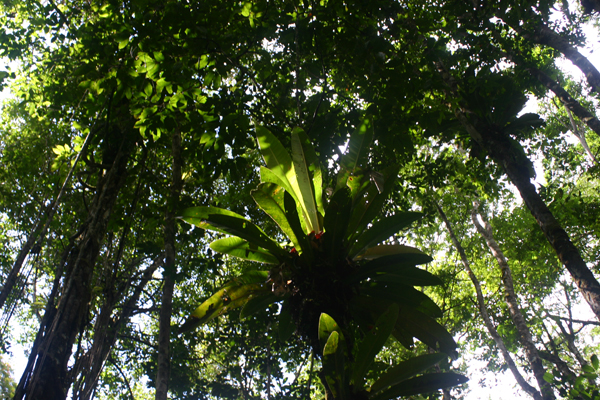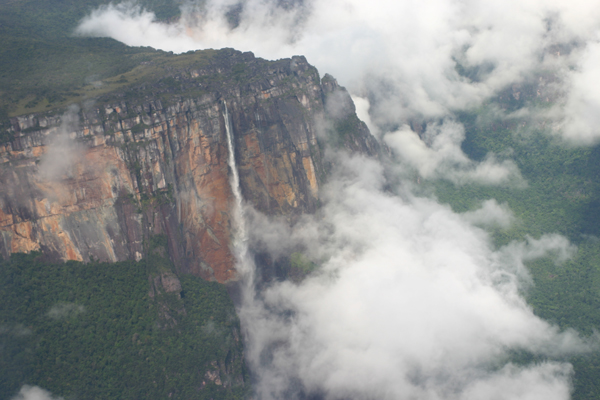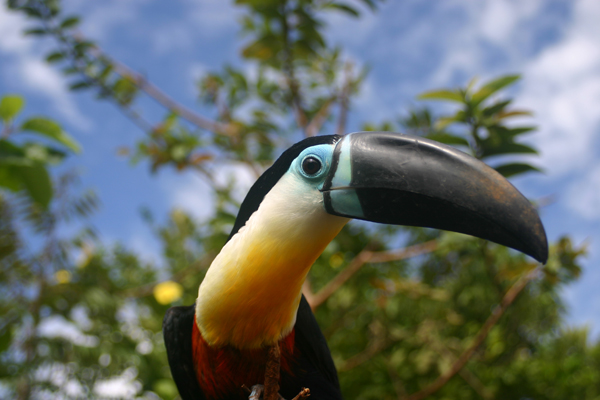Angel Falls
Venezuela is a land of spectacular scenery and many waterfalls. It is thus only fitting that it is home to the highest falls in the world, Angel Falls. Named not after heavenly bodies but more prosaically after the derring-do American aviator, Jimmy Angel, who crash-landed on the summit of Ayuantepui, the tepui from which the waters of Angel Falls cascade nearly a kilometre to their fate below.
Being less adventurous than Angel, I joined a group of Venezuelan tourists and headed upstream on the Caro River in a long wooden dugout. Despite our proximity to the equator we had to huddle low in the dugout, trying in vain, to avoid the penetrating chill of the dawn as we sped over the still waters of the river. The waters were dark enhancing the warming embers of dawn with a perfect and enchanting reflection.
The jungle, a riot of undergrowth, clambered for space at the river’s edge, branches, tree trunks and foliage spilling over into the water. The jungle was unmoving and quiet, the unnatural sound of our motor announcing our arrival and silencing all.
That is except for the birds. The noisy radio squawking overhead of parakeets, toucans glided from perch to perch, swallows fluttered haphazardly and kingfishers darted decisively along the water’s edge.
The river snaked and worked its way around harder rocks in a series of curves and bends. Negotiating small bubbling raids, the bottom of the dugout gently scraping rocks, we made slow progress upriver scanning the banks in vain for signs of animal life.
A tangled, engorged mass of roots covered the jungle floor, frustrating footsteps and making progress difficult. I was relieved to see that no wooden boardwalks or steps had been built to pander to pampered tourists. It added to the drama of the approach. The natural beauty of the sight was also thankfully not denigrated or demeaned by protective railings and signs.
Angel Falls does not need boards or sign to announce its presence. Its grandness, its height, its beauty speaks eloquently enough for itself. As I caught my first glimpse of the Falls I literally did, clichéd as it might sound, gasp in awe.
Nearly one kilometre above me two channels of water spilled over the dramatic edge unaware of the vertiginous drop below. It fell and fell and fell. I tried to follow a drop from the top to the bottom. It was impossible. Before my drop had got even a third of the way down I had lost it in a shower of fine spray. I tried again. Again and again. I gave up and focused on the bottom third, by which time my original drop had possibly only just reached this section. It was mesmerising and I totally lost myself in the fate of all those millions of drops of water in their stomach churning fall.
Then suddenly the clouds rolled in enveloping the summit and rousing me from my reverie. I pinched myself, stunned by the sheerness of the height and drop.
I thought that it was to be my only view of the falls but was unaware that as you fly out of Cainama, the small airstrip that is the gateway to Angel Falls, the pilots indulge in a flyby of the Falls. I was also unaware of the breathtaking beauty of the falls and surrounding scenery from the air.
Once airborne, I was struck by the endless expanse of green that carpeted the land below. It was broken only by the tortuous bends of the Caro River along which we had travelled yesterday. I was intrigued to see from the air just how much the river meandered, winding, bend after bend after bend.
The geographical display that unfolded below and around us – for some minutes we were flying alongside the northern face of Ayuantepui - was quite simply astonishing. I have never seen such majestic scenery. The precipitous face of the tepui and the dramatic falls themselves; the weathered remnants of a ridge writhed in cloud standing in solitary defiance. It was awe inspiring.
|
|
|













